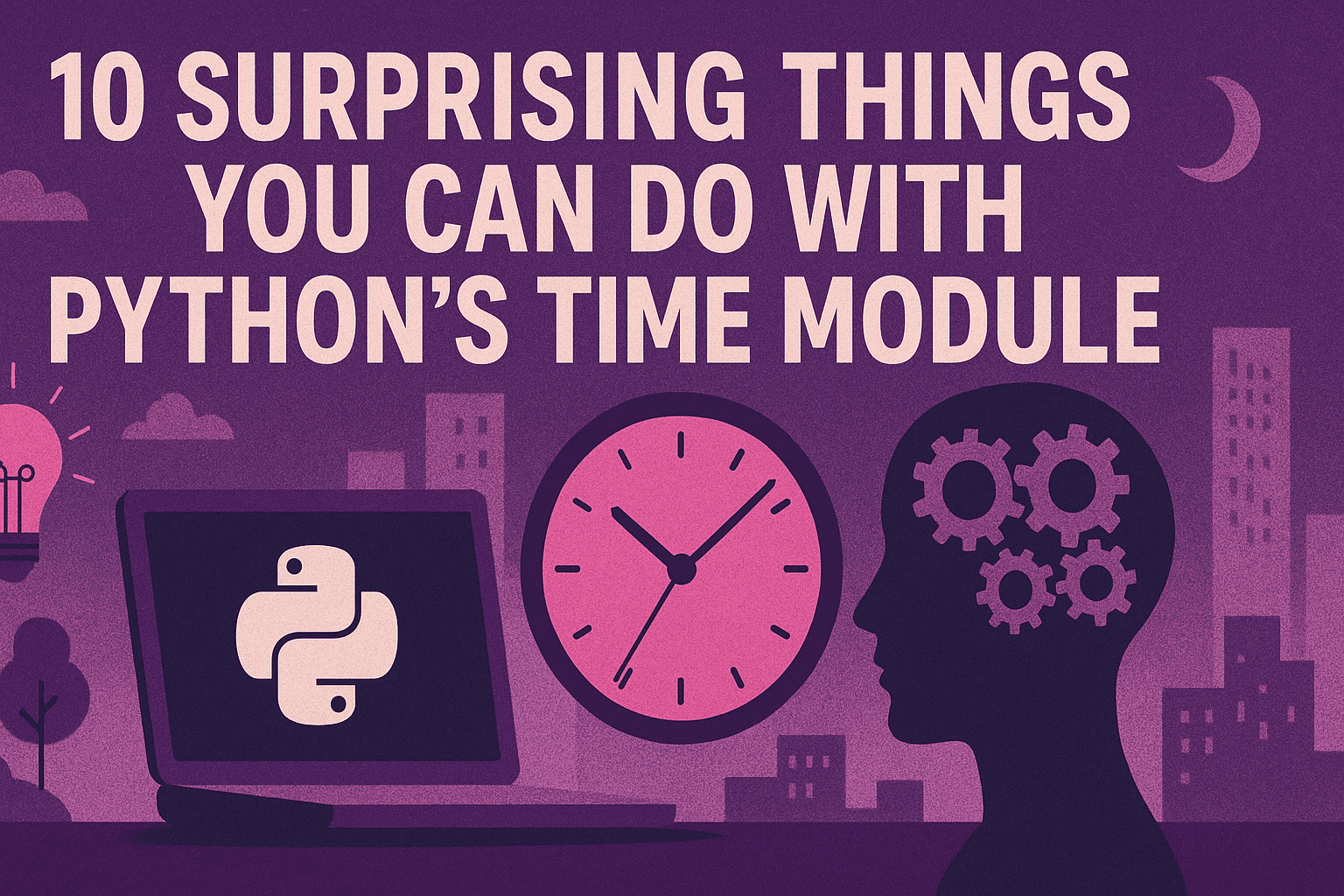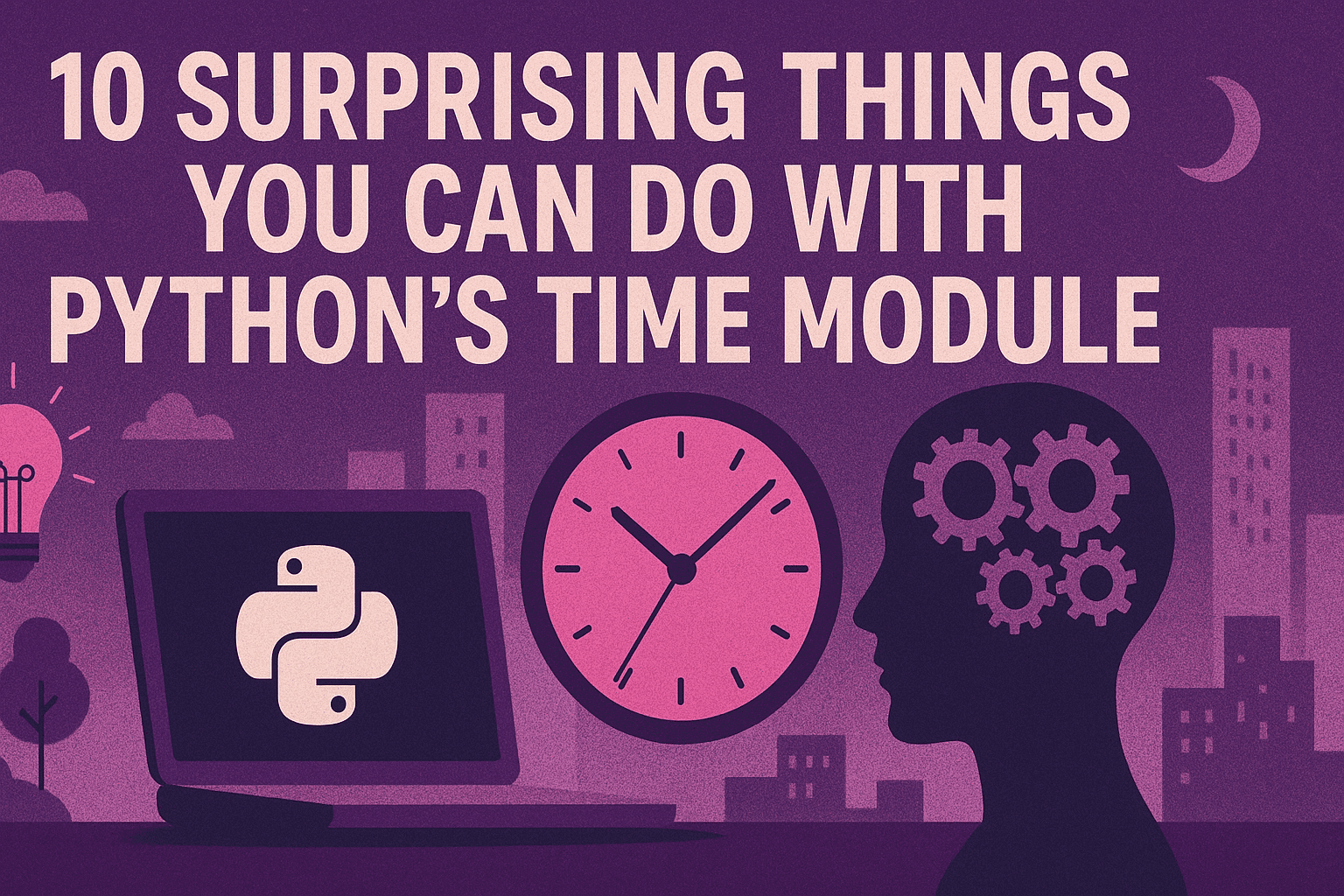Jobs & Careers
10 Surprising Things You Can Do with Python’s time module


Image by Editor | ChatGPT
# Introduction
Most Python developers are familiar with the time module, for its handy functions such as time.sleep(). This makes the modiule the go-to for pausing execution, a simple but essential tool. However, the time module is far more versatile, offering a suite of functions for precise measurement, time conversion, and formatting that often go unnoticed. Exploring these capabilities can unlock more efficient ways to handle time-related tasks in your data science and other coding projects.
I’ve gotten some flack for the naming of previous “10 Surprising Things” articles, and I get it. “Yes, it is so very surprising that I can perform date and time tasks with the datetime module, thank you.” Valid criticism. However, the name is sticking because it’s catchy, so deal with it 🙂
In any case, here are 10 surprising and useful things you can do with Python’s time module.
# 1. Accurately Measure Elapsed Wall-Clock Time with time.monotonic()
While you might automatically go for time.time() to measure how long a function takes, it has a critical flaw: it’s based on the system clock, which can be changed manually or by network time protocols. This can lead to inaccurate or even negative time differences. A more robust solution is time.monotonic(). This function returns the value of a monotonic clock, which cannot go backward and is unaffected by system time updates. This really does make it the ideal choice for measuring durations reliably.
import time
start_time = time.monotonic()
# Simulate a task
time.sleep(2)
end_time = time.monotonic()
duration = end_time - start_time
print(f"The task took {duration:.2f} seconds.")
Output:
The task took 2.01 seconds.
# 2. Measure CPU Processing Time with time.process_time()
Sometimes, you don’t care about the total time passed (wall-clock time). Instead, you might want to know how much time the CPU actually spent executing your code. This is crucial for benchmarking algorithm efficiency, as it ignores time spent sleeping or waiting for I/O operations. The time.process_time() function returns the sum of the system and user CPU time of the current process, providing a pure measure of computational effort.
import time
start_cpu = time.process_time()
# A CPU-intensive task
total = 0
for i in range(10_000_000):
total += i
end_cpu = time.process_time()
cpu_duration = end_cpu - start_cpu
print(f"The CPU-intensive task took {cpu_duration:.2f} CPU seconds.")
Output:
The CPU-intensive task took 0.44 CPU seconds.
# 3. Get High-Precision Timestamps with time.perf_counter()
For highly precise timing, especially for very short durations, time.perf_counter() is an essential tool. It returns the value of a high-resolution performance counter, which is the most accurate clock available on your system. This is a system-wide count, including time elapsed during sleep, which makes it perfect for benchmark scenarios where every nanosecond counts.
import time
start_perf = time.perf_counter()
# A very short operation
_ = [x*x for x in range(1000)]
end_perf = time.perf_counter()
perf_duration = end_perf - start_perf
print(f"The short operation took {perf_duration:.6f} seconds.")
Output:
The short operation took 0.000028 seconds.
# 4. Convert Timestamps to Readable Strings with time.ctime()
The output of time.time() is a float representing seconds since the “epoch” (January 1, 1970, for Unix systems). While useful for calculations, it’s not human-readable. The time.ctime() function takes this timestamp and converts it into a standard, easy-to-read string format, like ‘Thu Jul 31 16:32:30 2025’.
import time
current_timestamp = time.time()
readable_time = time.ctime(current_timestamp)
print(f"Timestamp: {current_timestamp}")
print(f"Readable Time: {readable_time}")
Output:
Timestamp: 1754044568.821037
Readable Time: Fri Aug 1 06:36:08 2025
# 5. Parse Time from a String with time.strptime()
Let’s say you have time information stored as a string and need to convert it into a structured time object for further processing. time.strptime() (string parse time) is your function. You provide the string and a format code that specifies how the date and time components are arranged. It returns a struct_time object, which is a tuple containing elements — like year, month, day, and so on — which can then be extracted.
import time
date_string = "31 July, 2025"
format_code = "%d %B, %Y"
time_struct = time.strptime(date_string, format_code)
print(f"Parsed time structure: {time_struct}")
print(f"Year: {time_struct.tm_year}, Month: {time_struct.tm_mon}")
Output:
Parsed time structure: time.struct_time(tm_year=2025, tm_mon=7, tm_mday=31, tm_hour=0, tm_min=0, tm_sec=0, tm_wday=3, tm_yday=212, tm_isdst=-1)
Year: 2025, Month: 7
# 6. Format Time into Custom Strings with time.strftime()
The opposite of parsing is formatting. time.strftime() (string format time) takes a struct_time object (like the one returned by strptime or localtime) and formats it into a string according to your specified format codes. This gives you full control over the output, whether you prefer “2025-07-31” or “Thursday, July 31”.
import time
# Get current time as a struct_time object
current_time_struct = time.localtime()
# Format it in a custom way
formatted_string = time.strftime("%Y-%m-%d %H:%M:%S", current_time_struct)
print(f"Custom formatted time: {formatted_string}")
day_of_week = time.strftime("%A", current_time_struct)
print(f"Today is {day_of_week}.")
Output:
Custom formatted time: 2025-08-01 06:41:33
Today is Friday
# 7. Get Basic Timezone Information with time.timezone and time.tzname
While the datetime module (and libraries like pytz) are better for complex timezone handling, the time module offers some basic information. time.timezone provides the offset of the local non-DST (Daylight Savings Time) timezone in offset seconds west of UTC, while time.tzname is a tuple containing the names of the local non-DST and DST timezones.
import time
# Offset in seconds west of UTC
offset_seconds = time.timezone
# Timezone names (standard, daylight saving)
tz_names = time.tzname
print(f"Timezone offset: {offset_seconds / 3600} hours west of UTC")
print(f"Timezone names: {tz_names}")
Output:
Timezone offset: 5.0 hours west of UTC
Timezone names: ('EST', 'EDT')
# 8. Convert Between UTC and Local Time with time.gmtime() and time.localtime()
Working with different timezones can be tricky. A common practice is to store all time data in Coordinated Universal Time (UTC) and convert it to local time only for display. The time module facilitates this with time.gmtime() and time.localtime(). These functions take a timestamp in seconds and return a struct_time object — gmtime() returns it in UTC, while localtime() returns it for your system’s configured timezone.
import time
timestamp = time.time()
# Convert timestamp to struct_time in UTC
utc_time = time.gmtime(timestamp)
# Convert timestamp to struct_time in local time
local_time = time.localtime(timestamp)
print(f"UTC Time: {time.strftime('%Y-%m-%d %H:%M:%S', utc_time)}")
print(f"Local Time: {time.strftime('%Y-%m-%d %H:%M:%S', local_time)}")
Output:
UTC Time: 2025-08-01 10:47:58
Local Time: 2025-08-01 06:47:58
# 9. Perform the Inverse of time.time() with time.mktime()
time.localtime() converts a timestamp into a struct_time object, which is useful… but how do you go in the reverse direction? The time.mktime() function does exactly this. It takes a struct_time object (representing local time) and converts it back into a floating-point number representing seconds since the epoch. This is then useful for calculating future or past timestamps or performing date arithmetic.
import time
# Get current local time structure
now_struct = time.localtime()
# Create a modified time structure for one hour from now
future_struct_list = list(now_struct)
future_struct_list[3] += 1 # Add 1 to the hour (tm_hour)
future_struct = time.struct_time(future_struct_list)
# Convert back to a timestamp
future_timestamp = time.mktime(future_struct)
print(f"Current timestamp: {time.time():.0f}")
print(f"Timestamp in one hour: {future_timestamp:.0f}")
Output:
Current timestamp: 1754045415
Timestamp in one hour: 1754049015
# 10. Get Thread-Specific CPU Time with time.thread_time()
In multi-threaded applications, time.process_time() gives you the total CPU time for the entire process. But what if you want to profile the CPU usage of a specific thread? In this case, time.thread_time() is the function you are looking for. This function returns the sum of system and user CPU time for the current thread, allowing you to identify which threads are the most computationally expensive.
import time
import threading
def worker_task():
start_thread_time = time.thread_time()
# Simulate work
_ = [i * i for i in range(10_000_000)]
end_thread_time = time.thread_time()
print(f"Worker thread CPU time: {end_thread_time - start_thread_time:.2f}s")
# Run the task in a separate thread
thread = threading.Thread(target=worker_task)
thread.start()
thread.join()
print(f"Total process CPU time: {time.process_time():.2f}s")
Output:
Worker thread CPU time: 0.23s
Total process CPU time: 0.32s
# Wrapping Up
The time module is an integral and powerful segment of Python’s standard library. While time.sleep() is undoubtedly its most famous function, its capabilities for timing, duration measurement, and time formatting make it a handy tool for all sorts of practically-useful tasks.
By moving beyond the basics, you can learn new tricks for writing more accurate and efficient code. For more advanced, object-oriented date and time manipulation, be sure to check out surprising things you can do with the datetime module next.
Matthew Mayo (@mattmayo13) holds a master’s degree in computer science and a graduate diploma in data mining. As managing editor of KDnuggets & Statology, and contributing editor at Machine Learning Mastery, Matthew aims to make complex data science concepts accessible. His professional interests include natural language processing, language models, machine learning algorithms, and exploring emerging AI. He is driven by a mission to democratize knowledge in the data science community. Matthew has been coding since he was 6 years old.
Jobs & Careers
TCS to Develop AI-Powered Financial System for Odisha Govt

Tata Consultancy Services (TCS) has been selected by the Odisha government to design and implement Integrated Financial Management System (IFMS) 3.0, an AI-enabled, cloud-native platform to modernise the state’s public finance management.
The new system will automate Odisha’s finance workflows using microservices-based architecture and integrate TCS’s AI Workbench (AIWB), which supports AI/ML projects across development, monitoring, and retraining.
Features will include AI-driven analytics, multilingual chatbot support, and automated service desk functions to improve efficiency and user experience.
Key features of IFMS 3.0 include a user-friendly interface for easier navigation, real-time integration of financial data across departments, advanced reporting and analytics tools, stronger security protocols to ensure compliance, and mobile accessibility that enables users to manage financial operations on the go.
TCS has partnered with Odisha since 2005, beginning with the state’s Treasury Management System, followed by IFMS and IFMS 2.0. This third-generation upgrade aims to provide real-time visibility, enhance data accuracy, and streamline processes across budgeting, expenditure, revenue, and accounts management.
“With real-time financial visibility, enhanced precision, and a future-ready architecture, this platform will empower Odisha to deliver more effective public services to its citizens,” Girish Ramachandran, president, growth markets and public services, TCS said.
“With AI-assisted insights and intuitive workflows, IFMS 3.0 will allow officials to monitor programs in real time, accelerate reporting, and make confident, data-driven decisions,” Tej Paul Bhatla, VP, public services, TCS said.
This initiative is part of TCS’s broader role in India’s digital transformation. For nearly six decades, TCS has been a technology partner to government programs, helping digitise services such as passport issuance, defence pensions, health insurance, and public financial systems. Nearly seven out of ten Indians use TCS-supported services daily.
The post TCS to Develop AI-Powered Financial System for Odisha Govt appeared first on Analytics India Magazine.
Jobs & Careers
6 in 10 Firms Expect AI to Act as Teammate or Supervisor to Other AI Systems by Mid-2026: Capgemini Report

Nearly six in 10 enterprises expect AI to function as a team member or supervisor for other AI systems within 12 months, according to the latest annual study from the Capgemini Research Institute.
The report, titled ‘Harnessing the Value of AI: Unlocking Scalable Advantage’, also mentions that the adoption of generative AI is outpacing organisational readiness, which is sparking challenges in cost, governance, and workforce adaptation.
The findings further reveal that one-third of organisations are now fully or partially scaling generative AI, compared with just 6% in 2023, a five-fold surge in two years.
About 93% of the survey companies said they are either piloting, deploying, or enabling AI capabilities in 2025, with sectors such as telecom, consumer products, and ae
Jobs & Careers
OpenAI Expands Beyond ChatGPT With New Jobs Platform, AI Skills Certification

OpenAI is moving into the hiring and training space with the launch of a Jobs Platform and new AI Certifications, aiming to connect millions of workers with employers and reshape how companies hire AI-savvy talent.
The company stated that the OpenAI Jobs Platform will serve as a marketplace where businesses can find workers trained in AI, while job seekers can showcase their verified skills. Unlike traditional hiring platforms, it will cater not only to large corporations but also to local businesses and governments looking for AI talent.
OpenAI is collaborating with a diverse network of partners for the same, including Walmart, John Deere, Boston Consulting Group, Accenture, Indeed, Texas Association of Business, Bay Area Council and Delaware Governor’s Office.
Meanwhile, OpenAI Certifications builds on the free OpenAI Academy, which has already reached over two million learners. OpenAI plans to certify 10 million Americans by 2030 in AI fluency, from basic workplace use to advanced prompt engineering.
Preparation and testing will take place inside ChatGPT itself. Walmart, the world’s largest private employer, is among the launch partners.
“At Walmart, we know the future of retail won’t be defined by technology alone—it will be defined by people who know how to use it,” John Furner, CEO of Walmart US, said in a statement.
The company says that the aim is to give more people economic opportunities as AI transforms work. “It’s all about being intentional about the kind of future we want to build,” the statement read, adding that the focus is on making AI literacy accessible and useful for both workers and employers.
The initiatives are also a part of OpenAI’s commitment to the White House’s AI literacy push. With hundreds of millions already using ChatGPT weekly, OpenAI believes its next big move lies in jobs and skills territory traditionally dominated by hiring and training platforms.
The post OpenAI Expands Beyond ChatGPT With New Jobs Platform, AI Skills Certification appeared first on Analytics India Magazine.
-

 Business1 week ago
Business1 week agoThe Guardian view on Trump and the Fed: independence is no substitute for accountability | Editorial
-
Tools & Platforms4 weeks ago
Building Trust in Military AI Starts with Opening the Black Box – War on the Rocks
-

 Ethics & Policy1 month ago
Ethics & Policy1 month agoSDAIA Supports Saudi Arabia’s Leadership in Shaping Global AI Ethics, Policy, and Research – وكالة الأنباء السعودية
-

 Events & Conferences4 months ago
Events & Conferences4 months agoJourney to 1000 models: Scaling Instagram’s recommendation system
-

 Jobs & Careers2 months ago
Jobs & Careers2 months agoMumbai-based Perplexity Alternative Has 60k+ Users Without Funding
-

 Education2 months ago
Education2 months agoVEX Robotics launches AI-powered classroom robotics system
-

 Podcasts & Talks2 months ago
Podcasts & Talks2 months agoHappy 4th of July! 🎆 Made with Veo 3 in Gemini
-

 Funding & Business2 months ago
Funding & Business2 months agoKayak and Expedia race to build AI travel agents that turn social posts into itineraries
-

 Education2 months ago
Education2 months agoMacron says UK and France have duty to tackle illegal migration ‘with humanity, solidarity and firmness’ – UK politics live | Politics
-

 Podcasts & Talks2 months ago
Podcasts & Talks2 months agoOpenAI 🤝 @teamganassi

